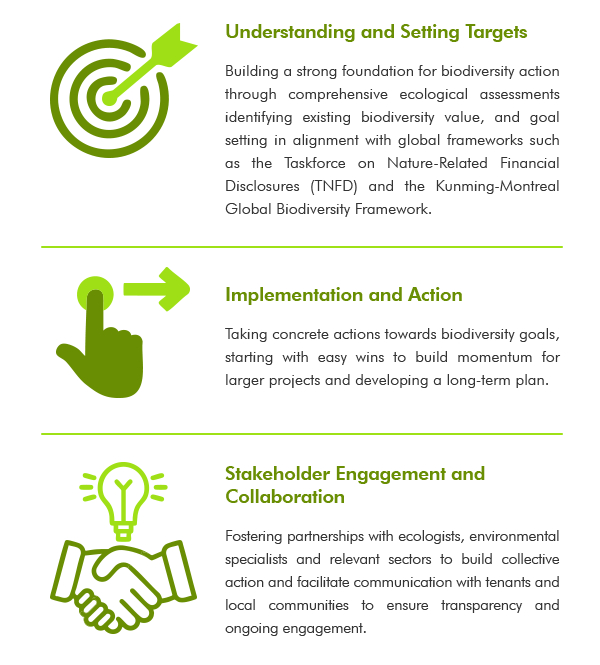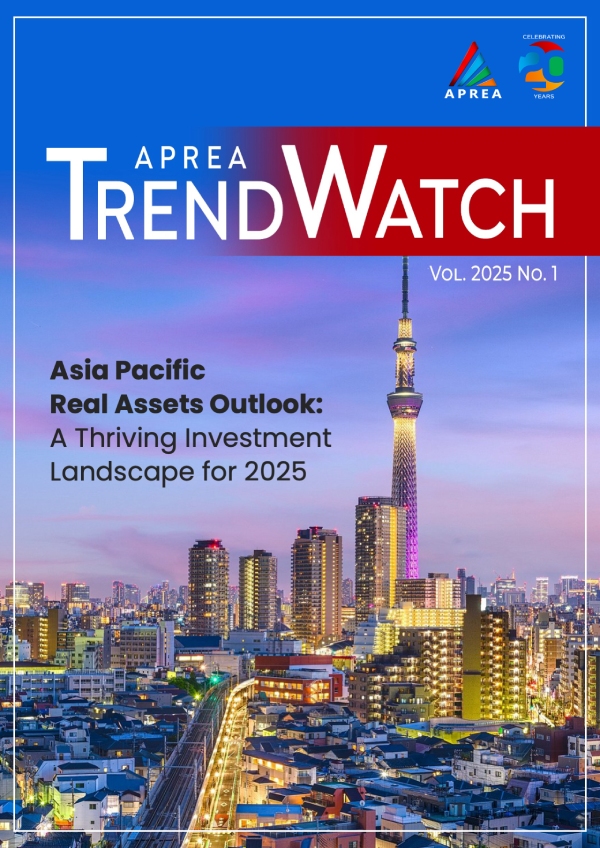The pressures on biodiversity are increasing, making it critical for the real estate industry to consider its impact, particularly across the Asia Pacific region where Southeast Asia alone hosts nearly 20% of the world’s known species within just 3% of the global land area.
Biodiversity contributes significantly to the functioning of ecosystem services such as clean air and water, climate regulation and disaster risk reduction which are essential for human well-being and economic stability. However, this is threatened due to this region’s rapid urbanization, deforestation, and agricultural expansion. For example, air and water pollution are the highest environmental risks that urban Asian cities face, with air pollution being the cause of one in five deaths in India in 2019, resulting in economic losses of USD 36 billion.
Driven by growing investor concerns and the need for robust ESG disclosures, regulatory trends are increasingly focusing on biodiversity. Initiatives like the UK's Biodiversity Net Gain (BNG) and the emergence of frameworks like the Taskforce on Nature-related Financial Disclosures (TNFD) are putting pressure on companies to disclose their environmental impacts and demonstrate how they are contributing to nature conservation.

The real estate sector, a significant contributor to biodiversity loss through land use, consumption of raw materials and disruption of natural cycles, is central to this shift. An upcoming white paper developed by CBRE in collaboration with Nature Positive and the Metis Institute acknowledges this and aims to explore the feasibility and benefits of incorporating biodiversity into green leases in Southeast Asia. Green leases serve as an important link between landlord and tenants on the sustainable objectives of a building, and including biodiversity within would help to integrate both party’s interests.
The white paper acknowledges several challenges when addressing biodiversity risks. Adoption and support for nature-based solutions is low due to weak legislation, lack of awareness, and maintenance difficulties . Additionally, the intangible benefits of nature-based solutions make it hard to justify the capital investments.
Despite these challenges, the real estate sector has a unique opportunity to turn the tide. By integrating biodiversity into urban development, the industry can enhance urban resilience to climate change effects, such as flooding and heatwaves, improving business continuity and urban liveability. Furthermore, properties that incorporate green spaces and biodiversity measures often see increased market values, as investors are attracted to the operability and resilience of the building, along with higher tenant satisfaction.
While the path forward is fraught with challenges, the potential benefits of addressing biodiversity risks present a compelling case for action within the real estate industry.
To get started, the real estate industry can consider the following actions.

Prioritising biodiversity should be a necessity in sustainable urban development in Asia Pacific before it is too late to salvage local ecosystems. By setting clear targets, engaging stakeholders, fostering collaboration, and prioritising quick wins, the real estate industry can play a crucial role in preserving the region's rich biodiversity while reaping significant economic and social benefits.

Head of ESG Consulting & Sustainability,
APAC, Paia FROM CBRE

Head of WELL & Circular Economy
Paia FROM CBRE

Head of Nature Solutions
Paia FROM CBRE
The Asia Pacific commercial real estate market will see a modest improvement this year on the back of a resilient regional economy and the downward interest rate cycle. However, the outlook by market and sector will vary, often significantly, leading us to adopt “Steady Growth, Split Performance: Navigating a Multispeed Recovery” as the central theme of our 2025 Asia Pacific Real Estate Market Outlook.
Economy: Asia Pacific GDP growth is forecasted to reach 4.1% in 2025. Although U.S. tariffs could weigh on regional growth, the precise implementation and impact of any new tariff regime remains uncertain. Policy rates across many Asia Pacific economies are forecasted to fall at relatively modest magnitudes, except for Japan, which is expected to implement further interest rate hikes this year.
Capital Markets: CBRE forecasts commercial real estate transaction volume to rise 5-10% y-o-y in 2025, driven by growth in Singapore, Korea, Australia and Hong Kong SAR, and continued investor interest in Japan and India. With individual Asia Pacific markets at different stages of the pricing cycle, yield movement will diverge across markets.
Office: Leasing activity and rents are expected to register modest growth, with flight to quality demand remaining prominent. This will drive additional requirements for high-quality office space in prime core locations, with properties in non-core areas set to become even less attractive.
Industrial & Logistics: Expansionary sentiment among logistics occupiers will gradually pick up this year, backed by a mild increase in requirements from manufacturers and e-commerce platforms. However, most occupiers will retain a cautious approach towards real estate portfolio planning amid high rental growth.
Retail: Consumer sentiment is expected to improve in 2025 amid the solid employment market, leading to stronger retail sales growth. Regional retail rents will continue their slow but steady recovery as retailers retain a cautiously optimistic attitude towards real estate planning.
Hotels: The outlook for the hotel sector is positive, with international tourism projected to complete its recovery in 2025. CBRE expects modest RevPAR growth in 2025, driven by further hotel occupancy gains as daily rates continue to moderate.
Download the Report Read MoreThe Asia-Pacific Horizon report examines the present economic and geopolitical landscape, evaluates the challenges and opportunities within the Residential and Commercial sectors, and provides guidance on unlocking potential.
Download the Report Read MoreThe Asia Pacific real assets market is set for a vibrant 2025, offering diverse investment opportunities across established cities such as Tokyo and Sydney, as well as emerging markets including India and Vietnam. Key drivers include economic expansion, infrastructure development, and shifts in global supply chains, leading to growing demand for sectors such as industrial logistics, multifamily housing, and data centers. These opportunities are further enhanced by urbanization, rising income levels, and the integration of technology and sustainability in real estate strategies. Despite challenges such as geopolitical risks and rising costs, the Asia Pacific remains a top choice for global investors seeking a balance of growth and stability.

CBRE’s 2025 Asia Pacific Investor Intentions Survey uncovered an improvement in buying intentions across most markets in Asia Pacific this year, with over half of respondents indicating their preference to buy more real estate in 2025. With the interest rate cut cycle underway in most markets, investors are gearing up for an increase in activity over the next 12 months, albeit with individual Asia Pacific markets staggered at different stages of the pricing and investment cycles.
Although real estate investment activity in most markets is forecasted to increase through 2025, the extent at which it will do so will differ according to location. While markets including Australia, Korea, Singapore, and Hong Kong SAR are expected to see gains in transaction activity in 2025, investors are less optimistic about the extent of rate cuts in 2025, which could weigh on investment sentiment throughout the year. After a strong 2024, Japan and India are expected to witness robust purchasing activity in 2025, with core/core-plus investment strategies in the former and opportunistic strategies in the latter most prevalent.
The survey was conducted in November and December 2024. Over 460 responses were received from participants who were asked a range of questions related to their buying intentions, perceived challenges and preferred investment strategies, sectors, and markets for the coming year.
Other key findings:
View the Report Read More